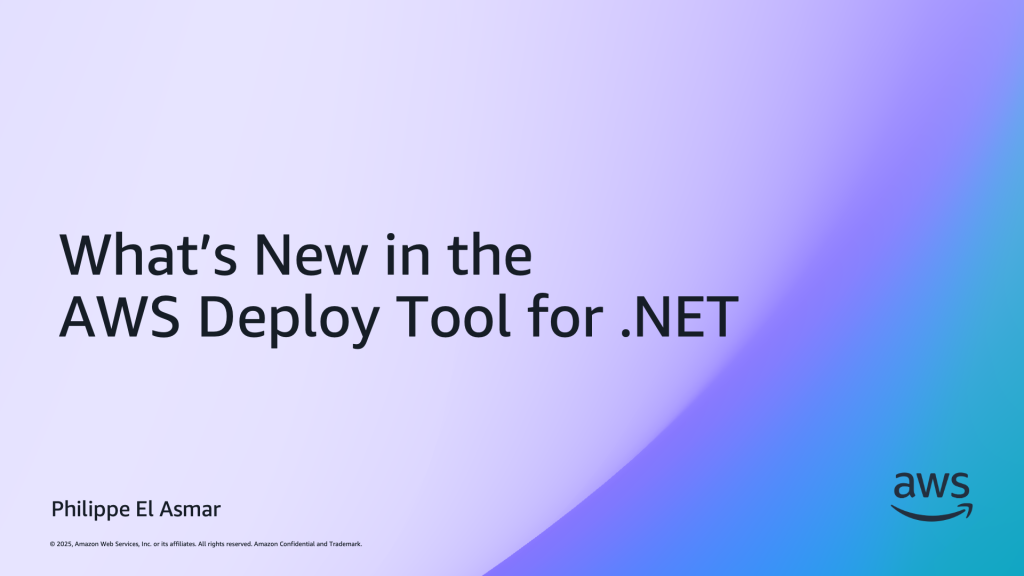AWS Developer Tools Blog
Category: .NET
What’s New in the AWS Deploy Tool for .NET
Version 2.0 of the AWS Deploy Tool for .NET is now available. This new major version introduces several foundational upgrades to improve the deployment experience for .NET applications on AWS. The tool comes with new minimum runtime requirements. We have upgraded it to require .NET 8 because the predecessor, .NET 6, is now out of […]
AWS .NET Distributed Cache Provider for Amazon DynamoDB now Generally Available
Today, we are excited to announce the general availability of the AWS .NET Distributed Cache Provider for Amazon DynamoDB. This is a seamless, serverless caching solution that enables .NET developers to efficiently manage their caching needs across distributed systems. Consistent caching is a difficult problem in distributed architectures, where maintaining data integrity and performance across […]
Deploy to ARM-Based Compute with AWS Deploy Tool for .NET
We’re excited to announce that the AWS Deploy Tool for .NET now supports deploying .NET applications to select ARM-based compute platforms on AWS! Whether you’re deploying from Visual Studio or using the .NET CLI, you can now target cost-effective ARM infrastructure like AWS Graviton with the same streamlined experience you’re used to. Why deploy to […]
Announcing the end of support for AWS DynamoDB Session State Provider
We are announcing the deprecation of the AWS DynamoDB Session State Provider for .NET. Support for this library will continue for the next six months and will officially end on November 14, 2025. After that date, we will no longer publish updates to the library, including security or critical bug fixes. Previously published releases will […]
General Availability of AWS SDK for .NET V4.0
Version 4.0 of the AWS SDK for .NET has been released for general availability (GA). V4 has been in development for a little over a year in our SDK’s public GitHub repository with 13 previews being released. This new version contains performance improvements, consistency with other AWS SDKs, and bug and usability fixes that required […]
Building and Debugging .NET Lambda applications with .NET Aspire (Part 2)
In Part 1 of our blog posts for .NET Aspire and AWS Lambda, we showed you how .NET Aspire can be used for running and debugging .NET Lambda functions. In this part, Part 2, we’ll show you how to take advantage of the .NET Aspire programming model for best practices and for connecting dependent resources […]
Building and Debugging .NET Lambda applications with .NET Aspire (Part 1)
In a recent post we gave some background on .NET Aspire and introduced our AWS integrations with .NET Aspire that integrate AWS into the .NET dev inner loop for building applications. The integrations included how to provision application resources with AWS CloudFormation or AWS Cloud Development Kit (AWS CDK) and using Amazon DynamoDB local for […]
Integrating AWS with .NET Aspire
.NET Aspire is a new way of building cloud-ready applications. In particular, it provides an orchestration for local environments in which to run, connect, and debug the components of distributed applications. Those components can be .NET projects, databases, containers, or executables. .NET Aspire is designed to have integrations with common components used in distributed applications. […]
Preview 4 of AWS SDK for .NET V4
In August 2024, we announced the first preview of our upcoming version 4 of the AWS SDK for .NET. Since then we have continued making progress and released new previews as we go. At the time of writing this post, the SDK has released preview 4. In this post, we’ll take a look at some […]
JSON Structured Logging for .NET Lambda Functions
We are announcing support for JSON structured logging for the .NET managed runtime. This makes the .NET managed runtime compatible with the previously announced logging controls for AWS Lambda, allowing you to toggle logging format and log levels using the Lambda API. Formatting log messages as JSON documents makes it easier to search, filter, and […]









